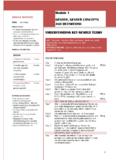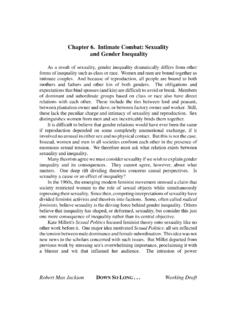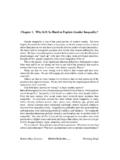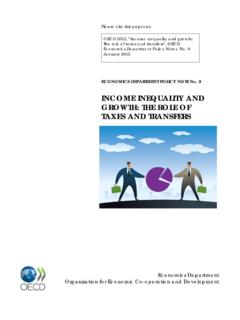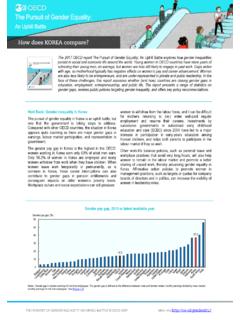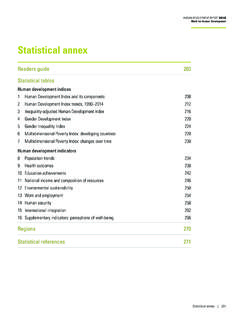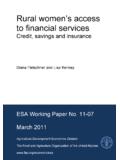Transcription of THE MPACT OFGENDER INEQUALITY IN EDUCATION AND …
1 Feminist Economics 15(3), July 2009, 91 132. THE IMPACT OF gender INEQUALITY IN. EDUCATION AND EMPLOYMENT ON. ECONOMIC GROWTH: NEW EVIDENCE. FOR A PANEL OF COUNTRIES. Stephan Klasen and Francesca Lamanna ABSTRACT. Using cross-country and panel regressions, we investigate to what extent gender gaps in EDUCATION and employment (proxied using gender gaps in labor force participation) reduce economic growth. Using the most recent data and investigating an extended time period (1960 2000), we update the results of previous studies on EDUCATION gaps on growth and extend the analysis to employment gaps using panel data. We find that gender gaps in EDUCATION and employment considerably reduce economic growth. The combined costs'' of EDUCATION and employment gaps in the Middle East and North Africa, and South Asia amount respectively to and percentage point differences in growth compared to East Asia.
2 gender gaps in employment appear to have an increasing effect on economic growth differences between regions, with the Middle East and North Africa, and South Asia suffering from slower growth in female employment. K EY W O R D S. Economic development, economic growth, economics of gender JEL Codes: J7, J16, O4. INTRODUCTION. There are many reasons to be concerned about existing gender inequalities in important well-being-related dimensions such as EDUCATION , health, employment, or pay. From a well-being and equity perspective, such gender inequalities are problematic as they lower well-being and are a form of injustice in most conceptions of equity or While such a view would argue for reducing gender inequalities in these dimensions of well-being on intrinsic grounds, recently, a literature has developed that has investigated the instrumental effects of gender INEQUALITY on other important development outcomes, with a particular focus on economic growth.
3 Without denying the importance of reducing gender INEQUALITY on intrinsic grounds, this paper is a contribution to this latter literature. Feminist Economics ISSN 1354-5701 print/ISSN 1466-4372 online 2009 IAFFE. DOI: ARTICLES. An important focus of this literature has been to examine the impact of gender INEQUALITY in EDUCATION on economic A number of theoretical contributions have suggested a negative link between gender INEQUALITY and economic growth (for example, Oded Galor and David N. Weil [1996] and Nils-Petter Lagerlo f [2003]). This literature shows that, largely due to the impact of female EDUCATION on fertility and the creation of human capital of the next generation, a lower gender gap will spur economic development. The next section will briefly summarize the main findings from this literature.
4 In parallel, an empirical literature has also examined these effects. While some earlier studies suggested that gender INEQUALITY in EDUCATION might actually increase economic growth (Robert Barro and Jong-Wha Lee 1994;. Robert Barro and Xavier Sala-i-Martin 1995), more recent work has shown that the opposite appears to be the case (M. Anne Hill and Elizabeth M. King 1995; David Dollar and Roberta Gatti 1999; Kristin Forbes 2000;. Stephen Knowles, Paula Lorgelly, and Dorian Owen 2002; Stephan Klasen 2002; Steven Yamarik and Sucharita Ghosh 2003; Dina Abu-Ghaida and Stephan Klasen 2004). These studies not only differ from previous analyses in their findings of the impact of gender INEQUALITY on economic growth, but they also explain why earlier studies found the opposite effect and why more careful econometric techniques yield the new finding that gender INEQUALITY in EDUCATION reduces economic These macro studies are also consistent with findings using micro data showing that girls have a higher marginal return to EDUCATION , which is even higher if the impact of female EDUCATION on fertility and EDUCATION of the next generation is included (Hill and King 1995; World Bank 2001.)
5 Elizabeth M. King, Stephan Klasen, and Maria Porter 2008). The effects found are quite large for the regions where gender INEQUALITY is sizable, such as South Asia or the Middle East and North Africa (MENA). In fact, Klasen (2002) estimated that percentage points of the percentage point annual per capita growth difference between the countries in MENA and those in East Asia and the Pacific (EAP) can be attributed to higher initial gender INEQUALITY in EDUCATION there as well as a slower closing of the gap vis-a`-vis While these results are instructive, they are based on information on EDUCATION and economic performance until 1990. Since new data on edu- cation achievement and economic performance that now stretch to 2000. have recently become available, one purpose of the paper is to update the findings of the impact of gender INEQUALITY on economic growth.
6 We will do this by using an updated and extended data set and the same econometric specification that was used in Klasen (2002). For some regions (including the MENA region), an update is particularly germane, as the gender gaps in EDUCATION have recently been closing more rapidly, so one would expect smaller but still remarkable costs for the existing gender gap in EDUCATION . 92. gender INEQUALITY AND GROWTH. A subject that has not been investigated in great detail is the impact of gender INEQUALITY in employment and pay on economic growth. The relatively small theoretical literature on the subject yields conflicting results (for example, Robert Blecker and Stephanie Seguino [2002], Berta Esteve-Volart [2004], and Tiago de Cavalcanti and Jose Tavares [2007]). While there is some empirical literature suggesting that high earnings gaps, combined with high female labor force participation rates, helped spur export-oriented economic growth in some Asian countries (for example, Stephanie Seguino [2000a, 2000b] and Matthias Busse and Christian Spielmann [2006]), there has not been a thorough empirical investigation of the role of gender gaps in employment on economic growth, and the few existing studies have to be treated with caution due to problems of endogeneity, unobserved heterogeneity, and poor data availability and quality.
7 These issues can best be treated in a panel framework, where one considers the impact of initial employment on subsequent economic growth, and thus can at least partly address issues of endogeneity and unobserved heterogeneneity. Unfortunately, such panel data is only available for labor force participation rates by sex, not for employment by sex; we show below, however, that available data suggest that gender gaps in labor force participation and employment are closely correlated, so one can well proxy for the other. With forty years of data, an analysis of the gender gaps in labor force participation is now possible, and therefore a second aim of the paper is to investigate the impact of gender gaps in labor force participation (as a proxy for gender gaps in employment) on economic growth in such a panel framework.
8 G E N D E R I N E Q U A L I T Y A N D E C O N O M I C P E R F OR M A N C E : T H E O R Y A ND EV I D E N C E. There have been a number of theoretical and empirical studies finding that gender INEQUALITY in EDUCATION and employment reduces economic The main arguments from the literature, which are discussed in detail in Stephan Klasen (1999, 2002, 2006), are briefly summarized below. Regarding gender INEQUALITY in EDUCATION , the theoretical literature suggests as a first argument that such gender INEQUALITY reduces the average amount of human capital in a society and thus harms economic per- formance. It does so by artificially restricting the pool of talent from which to draw for EDUCATION , thereby excluding highly qualified girls (and taking less qualified boys instead; see, for example, Dollar and Gatti [1999]).
9 Moreover, if there are declining marginal returns to EDUCATION , restricting the EDUCATION of girls to lower levels while taking the EDUCATION of boys to higher levels means that the marginal return to educating girls is higher than that of boys, and thus would boost overall economic performance (World Bank 2001; Knowles, Lorgelly, and Owen 2002). 93. ARTICLES. A second argument relates to the externalities of female EDUCATION . Promoting female EDUCATION is known to reduce fertility levels, reduce child mortality levels, and promote the EDUCATION of the next generation. Each factor in turn has a positive impact on economic growth. Thus, gender gaps in EDUCATION reduce the benefits to society of high female EDUCATION (see, for example, Galor and Weil [1996]; Lagerlo f [2003]; World Bank [2001].)
10 And King, Klasen, and Porter [2008]). There is also an important timing issue involved here. Reduced fertility levels will, after some twenty years, lead to a favorable demographic constellation which David E. Bloom and Jeffrey G. Williamson (1998) refer to as a demographic gift.'' For a period of several decades, the working-age population will grow much faster than the overall population, thus lowering dependency rates with positive repercussions for per capita economic A third argument relates to international competitiveness. Many East Asian countries have been able to be competitive in world markets through the use of women-intensive export-oriented manufacturing industries, a strategy that is now finding followers in South Asia and individual countries across the developing world (see, for example, Stephanie Seguino [2000a, 2000b]).
